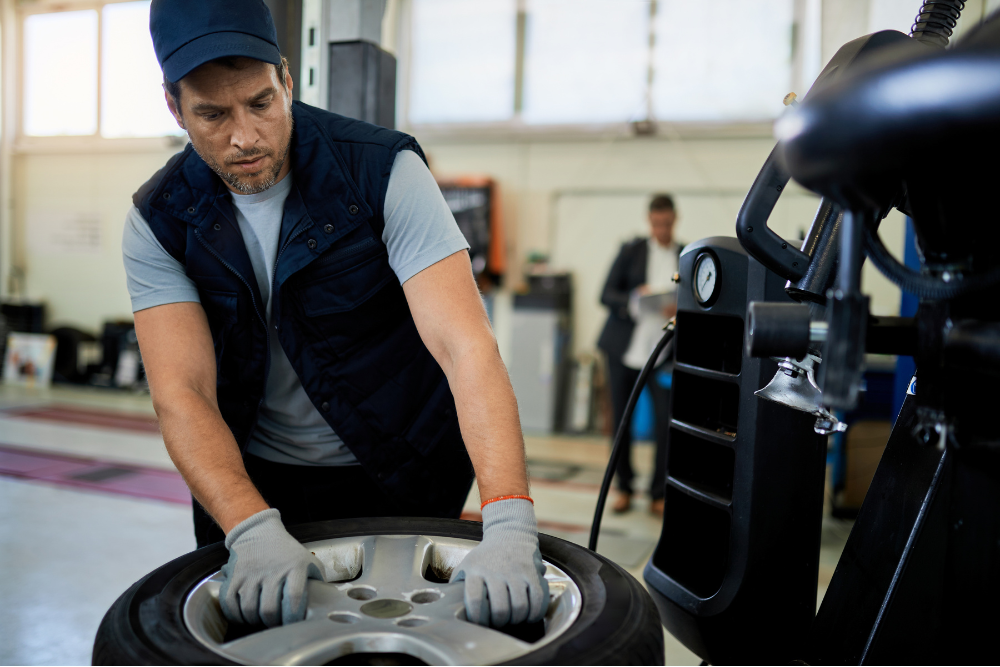Subtotal $0.00
Table of Contents
Introduction
Ever felt your car shaking or your steering wheel wobbling at highway speeds? That’s your car’s way of saying, “Hey, my tires might need balancing!”
Tire balancing makes sure the weight is evenly distributed around the wheel, making your ride smooth and steady. When they’re off balance, you’ll notice vibrations, uneven tire wear, or even strange noises.
Unbalanced tires don’t just make driving uncomfortable—they can wear out faster, strain your suspension, and hurt fuel efficiency. Worse, they compromise safety. A bouncing car doesn’t handle well, especially at higher speeds.
Balancing your tires keeps your ride smooth, extends tire life, and saves you money on avoidable repairs. Let’s dive in and learn how to spot and fix tire imbalance.
Key Signs Your Tires Need Balancing
Your car has ways of letting you know when something’s off—like unbalanced tires. Here’s what to watch for:
1. Vibrations While Driving
If your steering wheel shakes at higher speeds or you feel vibrations in the floor or seat, it’s likely your tires are unbalanced. Uneven weight distribution causes these noticeable shakes, especially at highway speeds.
2. Uneven Tire Wear
Check your tire tread. If one area is more worn than the rest, your tires aren’t wearing evenly. This happens when unbalanced tires put more pressure on specific spots, reducing their lifespan.
3. Noises From the Wheels
Humming, thumping, or other strange sounds from your tires could mean they’re unbalanced. These noises occur when uneven weight distribution causes the tires to wobble as they spin.
4. Decreased Fuel Efficiency
A sudden drop in MPG could be a sign of unbalanced tires. When your tires don’t roll evenly, your engine works harder, using more fuel.
5. Pulling to One Side
If your car drifts to one side, it could indicate unbalanced tires or alignment issues. Either way, it’s worth investigating.
Why Tires Become Unbalanced
Tires go out of balance for a few common reasons. Here’s what might be causing it:
1. Natural Wear and Tear
As you drive, your tires wear down, and the weight distribution shifts. Even normal use can cause small imbalances as the tread wears unevenly over time.
2. Hitting Potholes, Curbs, or Debris
Hitting potholes, curbs, or road debris can knock wheel weights out of place or damage your tires, throwing the balance off.
3. Improper Mounting or Repair Work
If tires aren’t mounted properly after installation or repair, they can start out unbalanced. Small errors during these processes lead to noticeable issues later.
4. Seasonal Changes and Tire Pressure
Temperature changes affect tire pressure. Cold weather causes it to drop, while warmer weather increases it. These fluctuations can create imbalances, especially if pressure varies between tires.
Consequences of Ignoring Tire Balancing
Ignoring tire balancing might seem like no big deal, but it can lead to serious issues for your car and your wallet. Here’s what can happen if you don’t address it:
1. Accelerated Tire Wear
Unbalanced tires wear unevenly, causing some areas to wear down faster than others. This means you’ll have to replace your tires sooner than necessary, costing you more money.
2. Potential Damage to Suspension and Steering Components
The vibrations from unbalanced tires put extra stress on your suspension and steering. Over time, this can lead to costly repairs as these parts wear out faster.
3. Increased Risk of Accidents
Unbalanced tires affect your car’s handling, making it harder to maintain control, especially at higher speeds. This increases the risk of accidents, particularly in emergency situations.
Preventive Tips
Here are a few simple steps to keep your tires balanced and avoid bigger issues:
1. Regularly Scheduled Tire Rotations and Balancing
Get your tires rotated and balanced every 5,000–7,500 miles. This helps ensure even wear and keeps your tires balanced longer. It’s an easy way to extend tire life and maintain a smooth ride.
2. Look for Damage After Impacts or Potholes
Check your tires after a pothole or similar impact. You can avoid more expensive repairs by identifying problems early on since a bump could knock things out of balance.
3. Track the condition and pressure of the tires regularly
At least once a month, check your tire pressure and make any necessary adjustments. Additionally, look for wear or damage on your tires. Frequent inspection extends the tire life and helps avoid imbalances.
Conclusion
Besides making your ride more comfortable, tire balancing also helps you stay safe, save money, and increase the life of your tires. Along with preventing those unpleasant vibrations and strange noises, balanced tires protect your vehicle from unnecessary damage.
It’s best to have things looked out as soon as possible if you’re experiencing any of the symptoms we listed, such as shaking, uneven tire wear, or strange noises. A quick fix of these little problems can help you avoid more serious (and pricey) problems later on.


